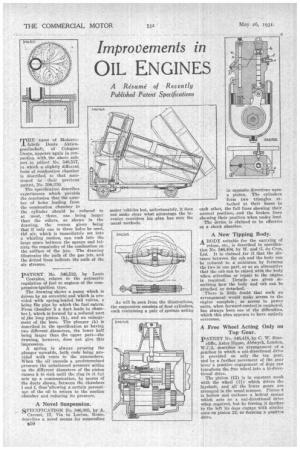Improvements in
Page 68

If you've noticed an error in this article please click here to report it so we can fix it.
OIL ENGINES
A Resume of Recently Published Patent Specifications
MHE name of Motoren fabrik Dents Aktiengesellschaft, of CologneDeutz, appears again in connection with, the _above subject in patent No. 346,517, in which. a slightly different form of combustion chamber is described to that mentioned in their previous patent,. No. 308,31(1. .
The specification describes experiments which provide the conclusion that the number of holes leading from the combustion chamber to - the cylinder should be reduced to at most, three, one being larger than the others, as shown in the drawing, the reason given being that if only one to three holes be used, thd' air, which is immediately set into a whirling motion, can rush into the large space between the sprays and initiate the remainder of the combustion on the sutface of the jets. The drawing illustrates the path of the gas jets, and the dotted lines indicate the path of the air streams.
PATENT No. 346,532, by Louis Coatalen, relates to the automatic regulation of fuel to engines of the compression-ignition type.
The drawing shows a pump which is driven by an eccentric and which is provided with spring-loaded ball valves, e being the pipe by which the fuel enters. From chamber h a duct leads to chamber 1, which is formed by a reduced part of the long piston (k), and an enlargement of the bore. The plunger (k) is described in the specification as having two different _diameters, the lower half being larger than the upper part—the drawing, however, does not give this impression.
A spring is always pressing the plunger lipwatds, both ends being provided with vents to the atmosphere. When the oil exceeds a predetermined pressure the unbalanced pressure acting on the different diameters of the piston causes k to sink until the ring in it (n) sets up a communication, by means of the ducts shown, between the chambers 1 and f, thus'allowing a certain percentage of the oil to return to the suction chamber and reducing its pressure.
A Novel Suspension.
SPECIFICATION No. 346,305, by A. Carozzi, 17, Via in Liicina, Rome, describes a novel means for suspending 1350 in opposite directions upon a piston. The cylinders form two triangles at tached at their bases to each other, the full lines chewing their normal position, and the broken lines showing their position when under load.
The device is claimed to be effective as a shock absorber.
A New Tipping Body. A BODY suitable for the carrying of
refuse, etc., is described in specification No. 346,464, by W. and G. du Cros, Ltd. It is claimed for it that the distance between the cab and the body can be re.cluced to a minimum by forming the two in one part, or as an alternative that the cab can be raised with the body when attention or repair to the engine is required. Details are given describing how the body and cab can be attached or detached.
There is little doubt that such an arrangement would make access to the engine complete; as access to power units, when forward-control is employed, has always been one of the difficulties, which this plan appears to have entirely overcome.
A Free Wheel Acting Only on Top Gear.
pATENT No. 346,418, by C. W. Stan diffe, Astor House, Aldwyeh, London, W.C.2, describes an arrangement of a. gearbox in which a uni-directional drive is provided on only the top gear, and by a further movement of the gear lever a positive engagement of dogs can transform the free wheel into a bi-directional drive.
The pinion (12) is in constant mesh with the wheel (11) which drives the layshaft, and all the lower sears are arranged in the usual manner. Pinion 8 is hollow and encloses a helical spring -which acts as a uni-directional drive when required, but by forcing it farther to the left its dogs engage with similar ones on pinion 12, so forming a positive drive.




































































































